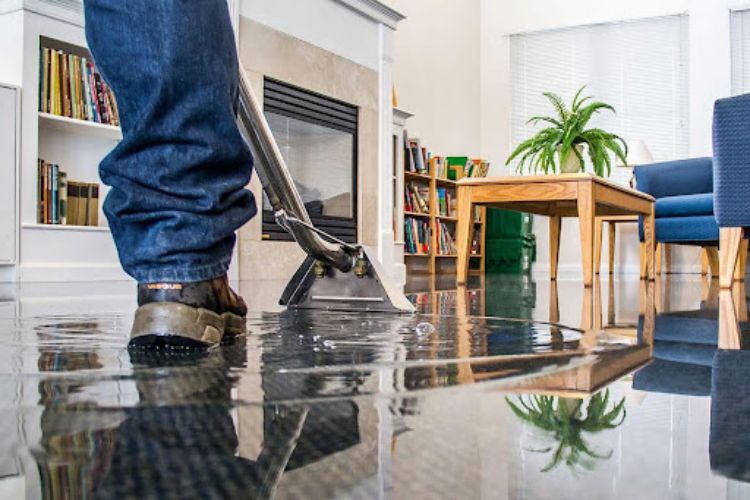Water moves quickly, so the circumstance the first day is the most intense in terms of recovery. The primary goals are clear: keep safe, stop the source, and start controlled drying. This free guide will walk you though the first 24 hours so you protect your health, structure, and future claims.
If you are searching Water Restoration Houston the different steps below will also be relevant for higher humidity weather and any kind of weather surge related to flooding.
Is It Safe to Enter the Property?
Before you come through the door, you should consider the potential hazards you can’t see. If you have never been in a flooded situation, things could start to get dangerous. Water can energize electrical circuits, weaken structural capacity, and/or carry excess contaminants. Take a moment to breathe, slow down, and quickly assess a safety plan.
These are possible structural red flags to look for: any sagging in your ceilings, bowing walls, is your floor so soft that it might be dangerous to walk on, do doors in the property jam suddenly. Once you enter the front door, the conditions in the property will change very quickly, so it is okay to take your time to minimize risks.
Assume all circuits are live until you can confirm they are off. Never approach standing water near appliances or outlets. If water comes from sewage, sewer and storm surge, or flood waters, it should be categorized as ‘Category 3’ black water and means you absolutely stay out until proper PPE has been issued.
Use gloves, boots and N95. Children, older adults and pets should not return until safety has been confirmed. When in doubt, get your utility company or an IICRC certified pro to give you a quick safety check.
Read more on what to do after water damage: https://www.angi.com/articles/how-fast-can-water-damage-ruin-home.htm
 Shutting Your Utilities Off
Shutting Your Utilities Off
If it is safe, turn off electricity to affected rooms at the breaker – unless you can actually see there is not a concern caused by water or flooding. Gas appliances and pilot lights need careful attention to lock down; don’t light anything on or turn on again until a technician has confirmed it is safe. If plumbing is the cause of the leak, turn off the main supply before stopping it at the source to prevent continuous intrusion of water into the structure.
The next phase for you is to look for the source, the root of the problem. In order to relieve pressure from a burst pipe, you should open the faucets after you have shut the main. If you have roof leaks or leaks from windows, set catch buckets and cover the outside opening with a tarp, if outside conditions allow. If you are dealing with flooding or typing Water Restoration Houston, you can use a cheap temporary sump pump and backflow wedge to spread the repeat intake intervals apart.
Should You Remove Wet Drywall?
Drywall functions like a sponge, and when wet (depending on how wet), drywall becomes food for mold within 24-48 hours. You want to do everything you can to alter all conditions to breach the mold timeline. Your decision would depend on how wet, how dirty the water was, and what is behind the wall. You can use a moisture meter, or use thermal imaging (if able) to confirm closeness to the surface and maximum distance travelled.
If…for clean water, and lighter wet-wicking, you can make a “flood cut” – 12-24 inches above the wet line – to vent the wall cavities. If the insulation rinsed away at all, plan on getting rid of it. Fiberglass batts will often hold water, creating delay in drying of the overall building process.
If there is either contact with sewage-contaminated or outdoor floodwaters, porous building materials will need to be discarded, and antimicrobial pre-treatments will be in the scope. Far role of priority will be ceilings that sag or stained – saturated ceilings move a failed roof and little or no consumer warning.
Document every cut made, and bag the debris for disposal records. Keep serial numbers in events of larger appliance losses. Click this to get some more ideas on what to do.
Documenting Damage For Insurance
Good documentation takes a stressful event and converts it into an easier project. Simple log with the date, time, and actions taken is a good start. Take photos of all the rooms from multiple angles before and after moving any items, and then do the close-ups of waterlines on walls, how much trim has swollen, and what contents have been damaged.
Look for the serial numbers and model information for any appliances and electronic equipment, keep all receipts for pumps, fans, and supplies. Keep samples of any flooring or carpet you remove for the adjuster, and take measurements of the rooms and the affected areas.
File quickly with your carrier, and make sure to note your claim number, and note if the loss is sudden/accidental in nature or a gradual seepage is excluded under the policy. Request written approval for any tear-out beyond emergency mitigation and keep copies of all emails and voicemails.
If you see mold growth, be sure to keep humidity readings and timelines to document; many coverage policies have limits on mold, so documenting early will matter.

